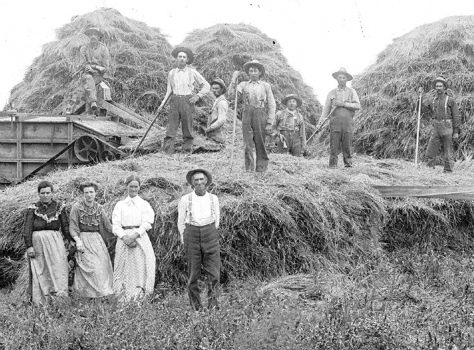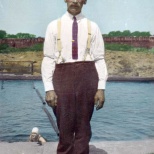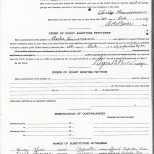Nestled within the two dozen photo collections in the Library of Congress American Memory project is an image of grain threshing on a Hanneman farm in central Nebraska in the opening years of the 20th century.
Work on the grain threshing stopped just long enough for the farm laborers to pose for a photograph taken by Solomon D. Butcher. The caption reads: “Threshing crew on farm of E.F. Hanneman, Watertown, Buffalo County, Nebraska.” The year was 1903. The image was submitted to the Library of Congress by the Nebraska State Historical Society.

The glass-plate negative photo is interesting for several reasons. One is the hand-drawn accents, such as the smoke coming from the steam engine and the straw pouring from the chute of the thresher. In the age of Adobe Photoshop and digital photo manipulation, these details might cause a chuckle. The “smoke” hardly looks real. But these details are charming nonetheless, a look at how photographers created detail and motion in photographs of that era.

The photo is not only of a Hanneman family farm, but it also has ties to Wisconsin. The “E.F. Hanneman” mentioned in the caption refers to Edward F. Hanneman, who lived much of his life in Buffalo County, Nebraska. Edward was born in Wisconsin in October 1880, presumably in Columbia County north of Madison. His family lived there for a time before moving west to Nebraska.

Edward’s father, Ernest Ludwig Friedrich Hanneman, was born in Pomerania in 1843. He came to America in 1861. Ernest’s parents, Dietrich and Maria Hanneman, settled in Columbia County, but had both died by 1880. Dietrich and Maria are buried in Hillside Cemetery in Columbus, Wis. By the time of the 1900 U.S. Census, the Ernest Hanneman family had settled in Amanda Township in Buffalo County, Nebraska.
We’ve noted on these pages before that Columbia County, Wisconsin, was one of the Wisconsin Hanneman enclaves in the late 1800s. There were others in Dane, Fond du Lac, Dodge, Marathon, Wood, Portage, Racine, Winnebago and Outagamie counties. My Hanneman line settled in Portage and Wood counties, starting in 1861. There could be a connection between the Dietrich Hanneman line and my line (Matthias Hanneman, 1794-1879). More research is needed.
Many, if not most, of the Hannemans who settled the U.S. Midwest in the 1800s came from the Duchy of Pomerania, a long-ago Baltic state which is now part of Poland and Germany. My family line goes back to at least 1550 in Kreis (county) Regenwalde, Pomerania. Some of the Marathon County Hannemans moved west and settled in Lake County, South Dakota. Some Hannemans who emigrated to Wisconsin later settled in Minnesota, Iowa, South Dakota, North Dakota and Nebraska.
The American Memory project was one of the Library of Congress’ early efforts to digitize some 5 million images from its trove of priceless photographs. It invited submissions from libraries and historical societies around the nation. The Edward F. Hanneman farm photo was part of the collection “Prairie Settlement: Nebraska Photographs and Family Letters.”
©2016 The Hanneman Archive
















































